11 Toucan Species to Amaze You!
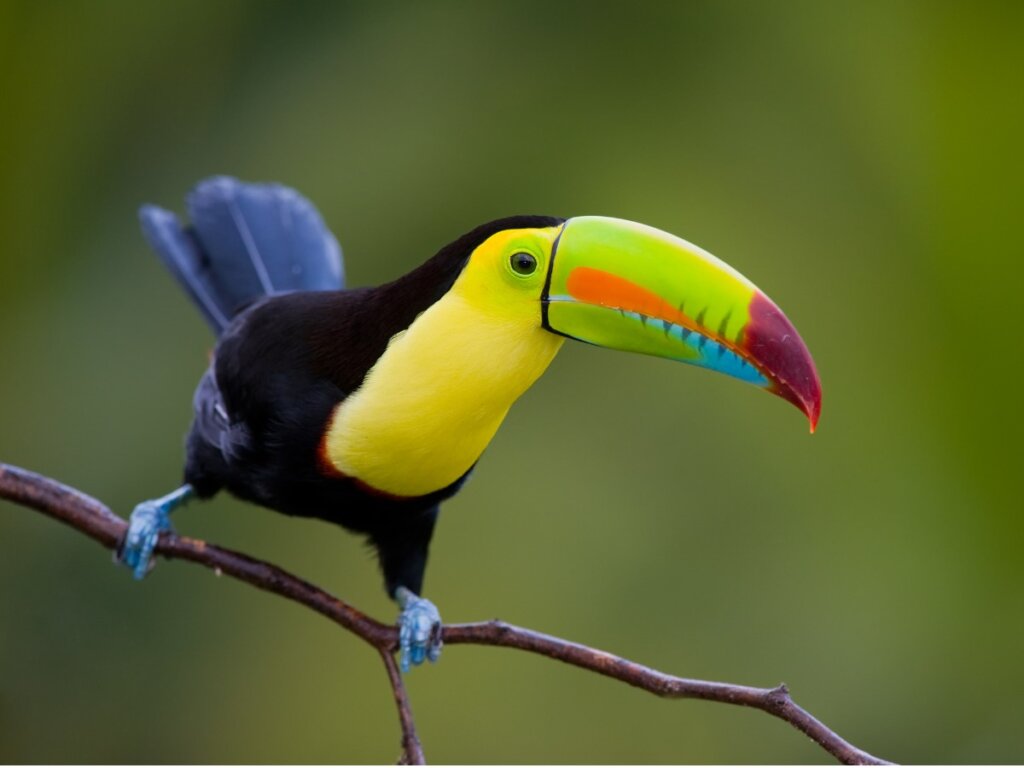
Experts tell us that there are about 42 toucan species, which are grouped into six genera, all of which belong to the ranphastid family or Ramphastidae. They’re birds that are part of the order of the Piciformes, like other birds, such as the bearded ones and the woodpeckers. Members of this taxon are distinguished by their exotic colors and large beaks.
In addition, toucans – also known as diostedé – are native to the tropical areas of South America, that is, they’re distributed throughout Mexico and Argentina. Of all the areas in the territory, their favorites are the low-altitude tropical rainforests. Read on to learn more about these birds.
Characteristics of toucan species
Toucans are one of the best-known bird species in the world due to their colors and distinctive beak. In fact, these are common characteristics in the different types of toucans, which we’ll talk about later.
Looking at the specifications of its beak, we find that it’s long, wide and curved, similar to a hook. Although the color black or dark brown predominates, its beak has several colors, as does its plumage. On the other hand, toucans can measure between 18 and 65 centimeters (7-25 inches) long and weigh up to 680 grams (24 ounces).
They’re arboreal birds, which is why they like jungles so much. They’re usually sedentary and feed on fruits. Because of that, they make short migrations and only in search of food. They also eat seeds, leaves, eggs, insects, and small vertebrates.
On the other hand, toucans have a characteristic that makes humans find them adorable: they’re monogamous. This means that throughout their lives they have the same partner. Together with his partner, the male builds a nest in the hollow of a tree, in which they lay their eggs and both of them incubate and raise the chicks.
Toucan species
According to some bird manuals, the names of some of the species that belong to the Ramphastidae family are derived from their song, among other characteristics. In this article, we’ll describe 4 genera of birds in depth, along with their typical morphology and habits. In all, we’re going to look at an amazing 11 different species!
Pichilingos (Selenidera)
The pichilingos or yellow-eared toucanet (Selenidera) are a genus of toucans that inhabit the forests of northern South America. Their beaks are black, white or different shades of gray, and they’re between 30 and 40 centimeters (12 – 16 inches) in size.
Males differ from females by their black throat and chest, while females have this area of brown color and a shorter beak. These are some of the species of the genus Selenidera :
- Black pichilingo (S. spectabilis): This is the largest species of the genus, measuring between 36 and 38 centimeters (14 inches) and weighing up to 245 grams (9 0z). Its beak is long with a black or gray baseline. The male has a black hood, yellow ear tufts and the female a chestnut crown and nape. Females don’t have ear tufts.
- Gouldian Toucan (S. gouldii): This is one of the easiest species to recognize due to its vibrant colors. The female is smaller than the male and has a shorter bill. This one has a mix of colors, as it’s white on the bottom and has an orange tip.
- Spotted-billed toucanet (S. maculirostris): In this species, a black color predominates in the male and an orange-brown color in the female. Both have 3 to 5 dark bands on their beaks, a green eyering, and a tuft of postocular feathers with a line that appears to form a yellow “A”.
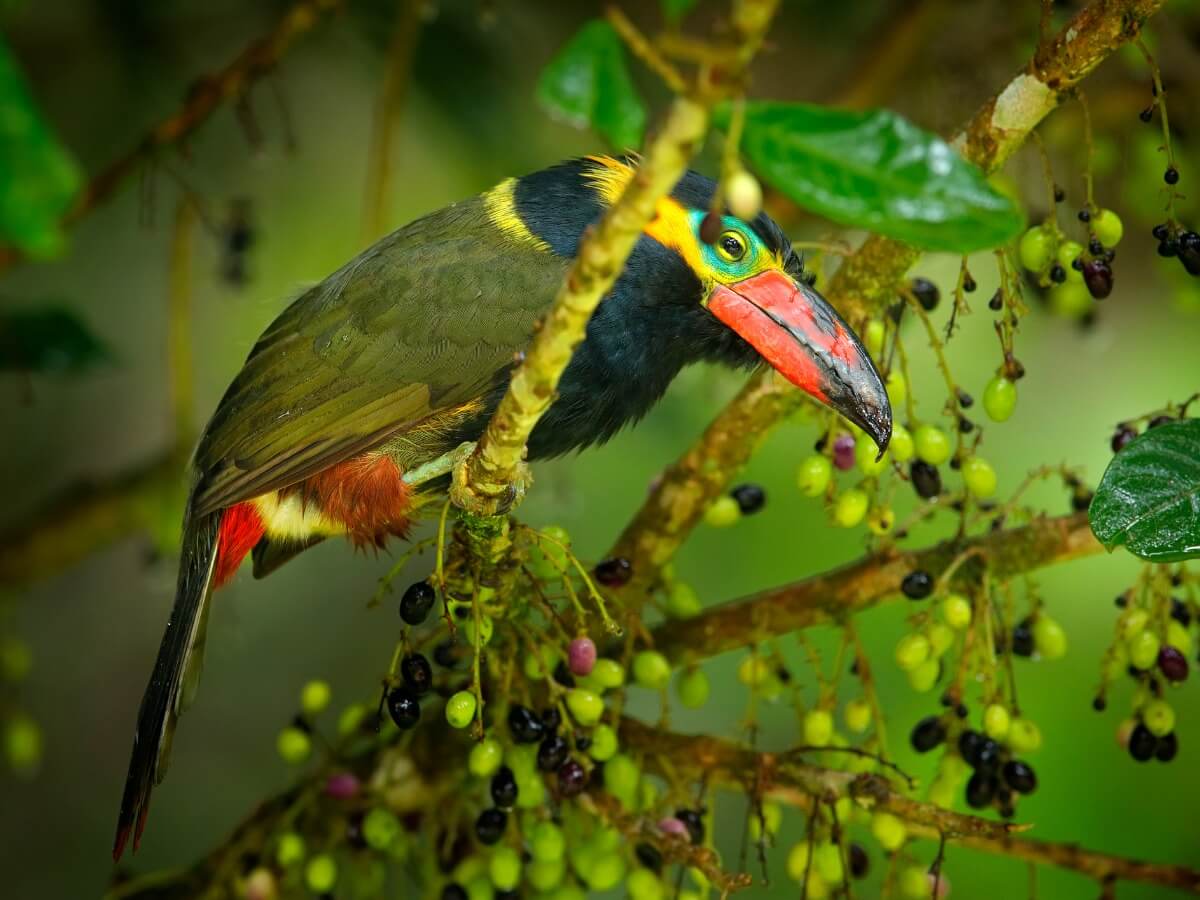
Aracaris (Pteroglossus)
Aracaris are toucans that live in the tropical areas of America or in the forests of the Neotropics, between the basins of the Amazon and Orinoco rivers. Members of the genus Pteroglossus are up to 40 centimeters long (16 inches) and have notable morphological differences depending on the species. Here are three of them:
- Arasarí de Azara (P. azara): This is small toucan species, found in the west of the Amazon. It has a red breast with a dark belly band and a yellow belly. Its beak is light yellow with dark spots.
- Collared Arasarí (P. torquatus): This toucan inhabits tropical forests and is characterized by having a long beak and tail. Its body is yellow with black markings of the same color, with a serrated pattern of the bill, black on the underside, and yellow with white on top.
- Green Arasarí (P. viridis): This is toucan species that has a light yellow belly and a dark chest. It emits a song that’s very similar to that of the woodpecker and has a very colorful beak.
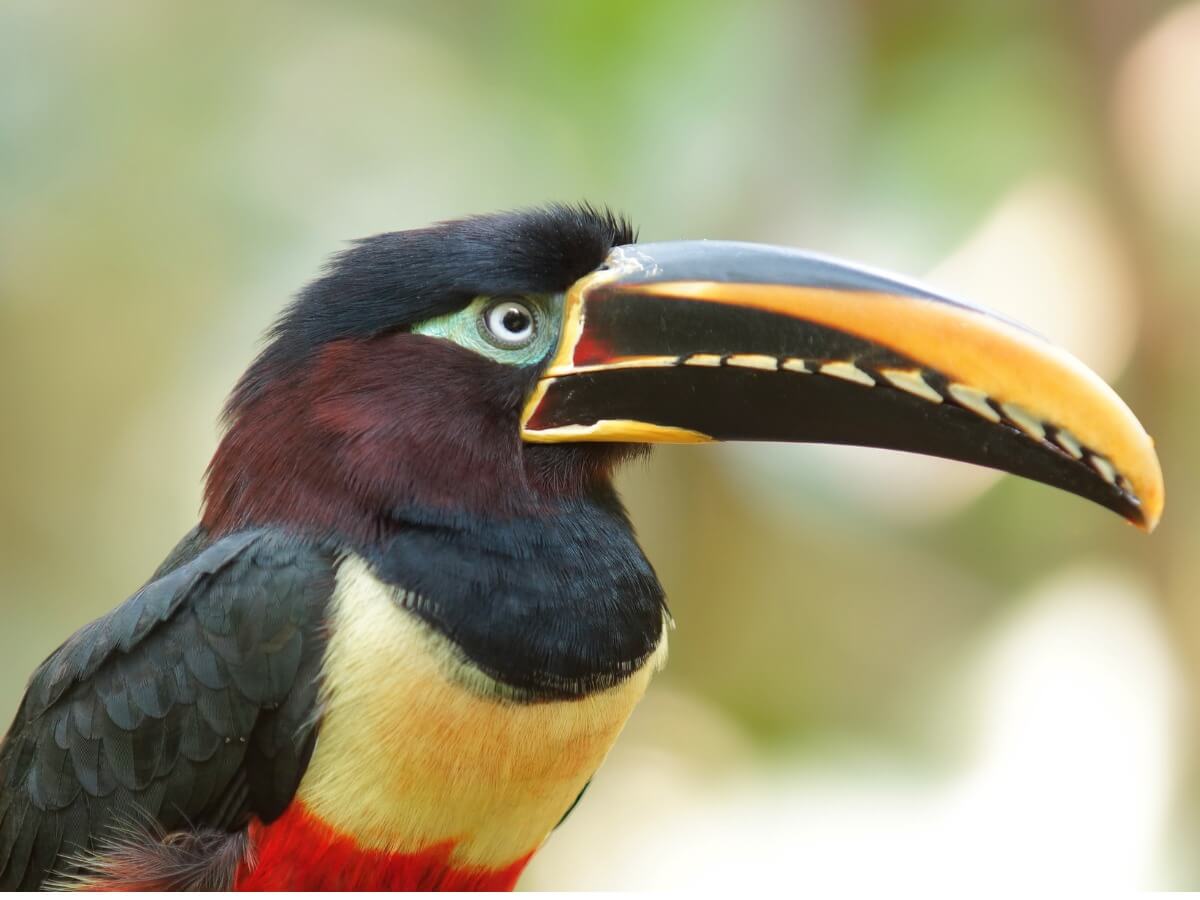
Toucanets (Aulacorhynchus)
The toucanets (Aulacorhynchus) are found throughout southern Mexico and Bolivia. Their main characteristics are their green color and small size. They are between 30 and 40 centimeters (12 – 16 inches) in length and boast a long, stepped tail. Their beaks are usually black, white, yellow or a reddish color. Here are some different toucanet species:
- Derby toucanet (A. derbianus): This is deep green in color, with a white throat, a brown tip on its tail, and a black beak with a white line at the base. Some of these birds also have red spots on the tip and base of their beaks.
- Green toucan (A. sulcatus): This bird has a black bill with a wide yellow area at the base and a white outline. Its eye area is bare and it has beautiful green tones in its feathers, with a blue tone on the throat. It has a brown tail and a light blue hue around its eyes.
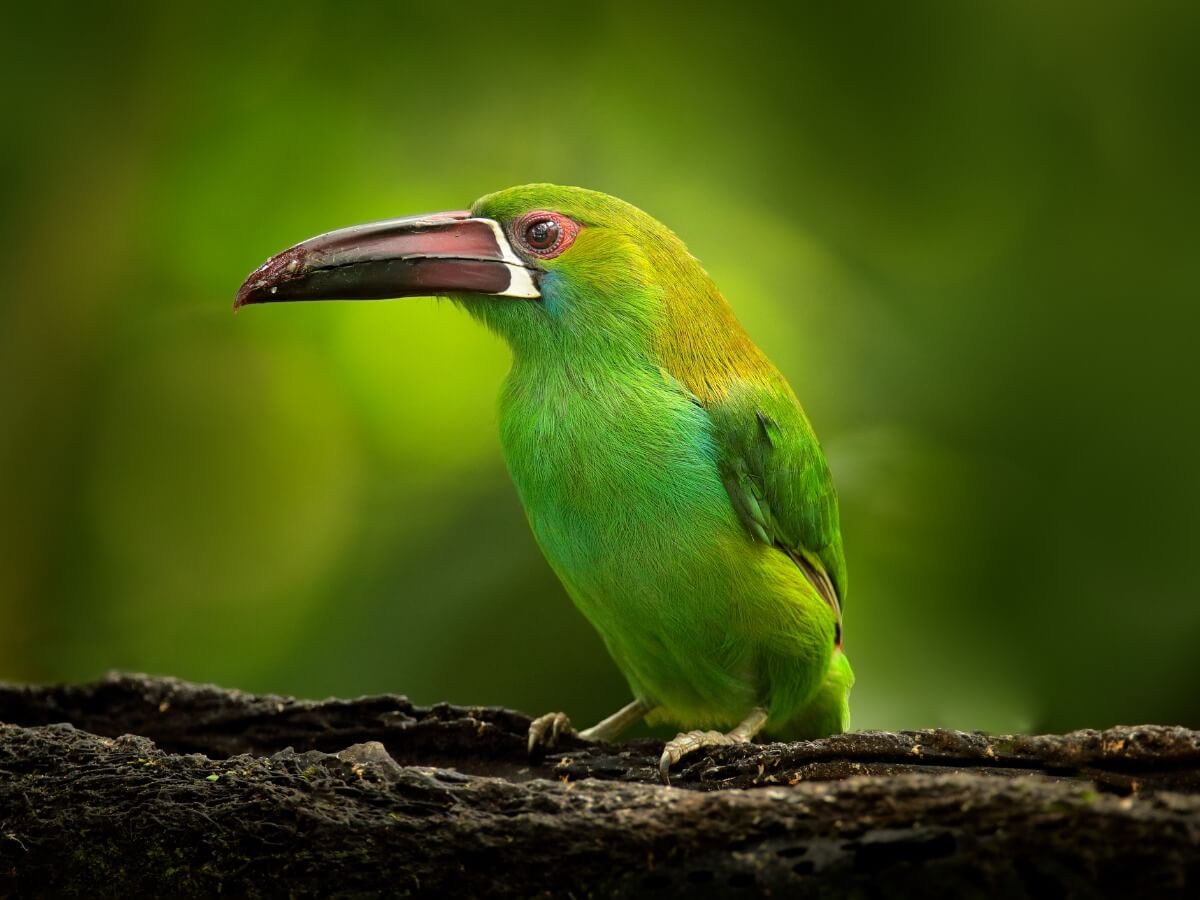
Toucans (Ramphastos genus)
Toucans belonging to the genus Ramphastos, are the most recognized birds in this family. They’re the largest and with the most striking beaks. In addition, their distribution is quite wide and you can find them in Mexico and Argentina.
In the wild, these birds can measure between 45 and 65 centimeters (17-25 inches) in length, while their beaks can reach up to 20 centimeters (12 inches). We’ll tell you more about this genus here:
- Toucan toco (R. toco): This bird is the largest member of the toucan family and inhabits the continent of South America. Most of its plumage is black and its throat is white with a blue eyering. Its large bill is yellow with a black spot. There’s no dimorphism between females and males.
- White-breasted toucan (R. tucanus): This bird is also large and, as its name confirms, it has a white breast, which stands out from its black plumage. Its beak is red with a light yellow line and it also has a blue-colored ring that extends around its eye.
- Iris, or multi-colored billed toucan (R. sulfuratus): Also known as the royal toucan, the iris has a multicolored beak on which yellowish-green predominates with a red or brown tip, which has a black band at its base. Also, their chest is bright yellow with a red stripe that separates this area from the body.
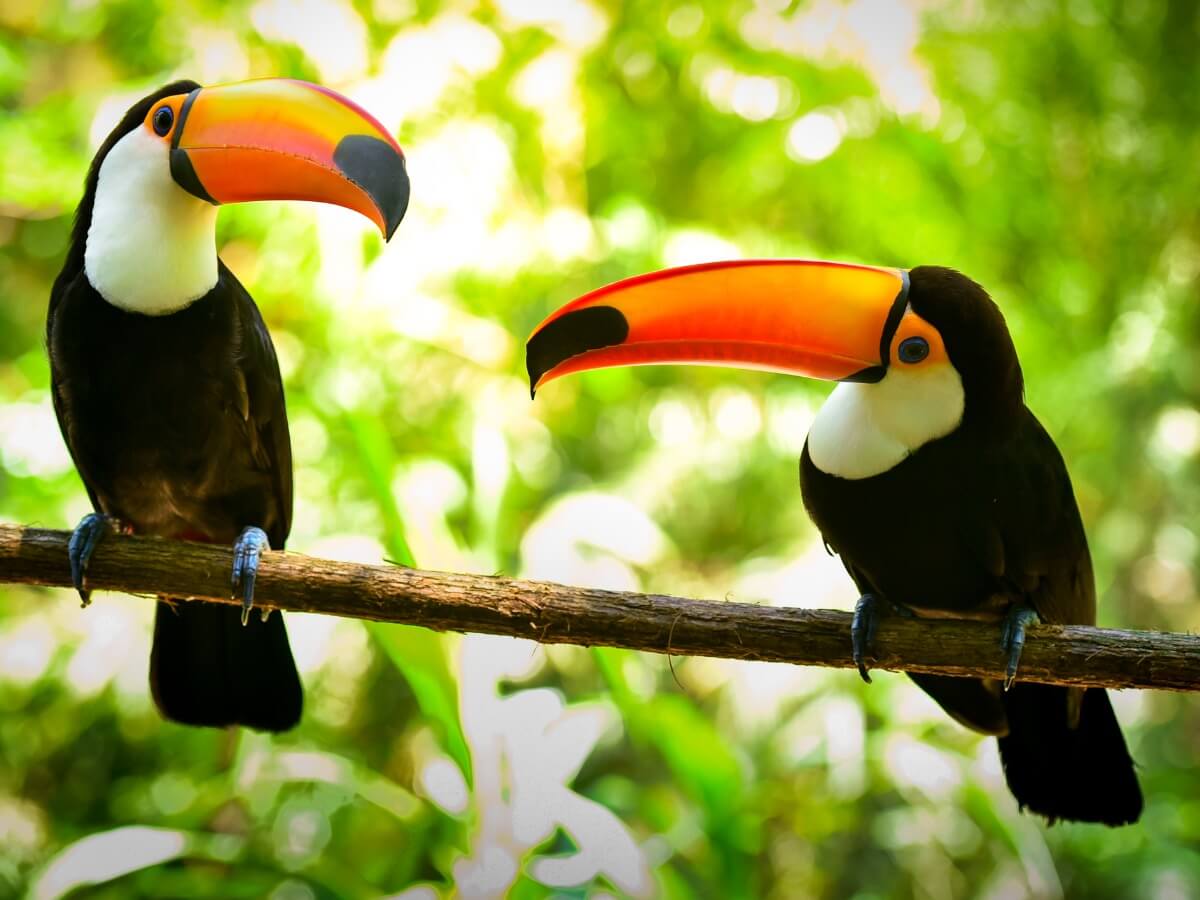
Conservation status of toucan species
Some species of toucans are in danger of extinction, while others are of less concern. Among the factors that contribute to the decline of these birds are predation and human hunting, as their beaks and feathers make them attractive for ornaments – which, of course, is illegal.
Added to this are the deforestation conditions currently facing the largest natural area in which these birds live: the Amazon. Likewise, toucans have often faced a lack of awareness from human beings, who, for a long time, have enjoyed their song and company in captivity, supporting biopiracy or illegal trafficking.
All cited sources were thoroughly reviewed by our team to ensure their quality, reliability, currency, and validity. The bibliography of this article was considered reliable and of academic or scientific accuracy.
- Hernández, Daniel & Tosi-Germán, Rafael & Píriz, Rosina & Muraña, Ivan & Cossio, César & Coitiño Banquero, Hugo & Rafael, Alberto. (2009). Confirmación de la presencia del tucán grande Ramphastos toco (Piciformes: Ramphastidae) en Uruguay. Boletín de la Sociedad Zoológica del Uruguay. 18. 35-38.
- Guía de las especies migratorias de la biodiversidad en Colombia. Dirección de Bosques, Biodiversidad y Servicios Ecosistémicos. 2012.
- Tucán arcoiris. División de Ambiente Centro de Información Ambiental de la Cuenca (CIAC), Panamá.
- Manual para facilitadores del Programa de Educación Ambiental. Las aves entran en las escuelas. Sociedad Conservacionista Audubon de Venezuela.
